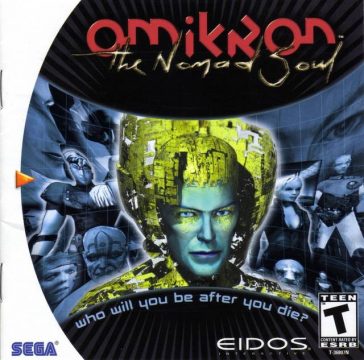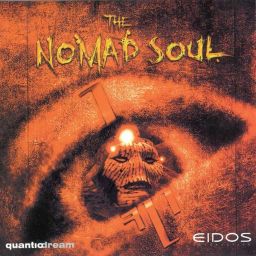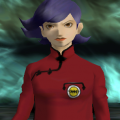DISCLAIMER: This article contains a major though early plot spoiler. Discussing the game’s later sections would be impossible without mentioning it and, significantly, being forewarned will likely increase your enjoyment of Omikron.
Given the death of David Bowie in January 2016 it seems appropriate to reflect on Omikron, a game he participated in and the first game from well known developer David Cage. Bowie contributed music to a wide variety of projects, including games, but with Omikron he also took the role of a celebrity NPC musician, playing three fully voiced music tracks at various in-game venues; a central plot-moving character who interacts directly with the player, looking like and voiced by Bowie himself; and apparently even aspects of Omikron‘s design and aesthetics. According to the credits Bowie’s wife also makes an appearance as an NPC (Iman 1631).
Along with being Cage’s first title, Omikron is also probably his best – at the very least it’s his most “gamey”. Subsequent works such as Fahrenheit / Indigo Prophecy, Heavy Rain, and Beyond: Two Souls may have higher production values, but the level of player interaction has gone down in each case as Cage pursues what appears to be a failed dream: making movies. Arguably making Cage the European answer to Hideo Kojima. This isn’t the case with Omikron though, which is so game-tastic, it actually blends multiple games into one chaotic whole. It’s part graphic adventure, part First Person Shooter (sometimes in a bipedal mecha), part one-on-one fighter, part body swap puzzler, part platformer (with swimming sections), all contained within a Grand Theft Auto / Shenmue-style 3D world framework… It’s too bad most of these sections cannot stand up on their own.
Firstly, it’s not quite GTA. Although there are vehicles and pedestrians, and Cage admitted to considering the option of allowing players to freely drive around, ultimately the vehicles are on fixed paths. You can ride them, but only in the form of taxis delivering you to pre-discovered addresses. The versus fights, with their simple kick/punch move sets, meanwhile resemble Virtua Fighter, but are shallow and suffer clunky controls. The fights are probably the most annoying aspect, so it’s worth dropping their separate difficulty level to Easy to bypass them as quickly as possible. The FPS sections are fun, but can’t challenge the quality of Half Life which was out at the time. They’re mainly small mazes filled with enemies who make a beeline for you, and there’s a little 3D wireframe map in the corner. Some FPS levels mix things up a bit, either by placing you inside a bipedal robot, or having you jump from rooftop to rooftop to reach an antenna.
The body swap mechanic, which in theory should have been a big selling point, feels forced and badly implemented. Only some bodies can be possessed and each usable body has various parameters for things like the versus fights; parameters can be improved through practice or training (a lot like in Shenmue). However, switching characters results in this resetting to the baseline of the new body. Most of the time these stats will be quite low, forcing you to grind for experience, or find an alternative more powerful body. It’s a complete waste of time, especially when you’re forced to switch bodies at various key points in the story. Building up the stats of a particular body only to lose it because of plot progression is as annoying as it sounds. The only stand-out moment for the body swapping is when you have to escape from prison – where you have to possess the body of the guard patrolling outside your cell. It’s a brilliant environmental puzzle, interwoven into the “nomad soul” aspect of the story, but it’s one of only a few examples. Once you leave a body it dies, so there’s no going back either!
The walking-about adventure sections work the best and, in all honesty, could have stood alone perfectly fine. There’s lots of clever little ideas, like examining the back of ID cards to find addresses to use in conjunction with taxis. The puzzle for acquiring the police precinct key, meanwhile, is ingenious and combines both item gathering and an understanding of your immediate environment. It’s elegant and nicely integrated. (Hint: search the kitchen for snacks and keep one handy.)
The unique story is the biggest draw, given that it hints at inspiration from various sources but is otherwise quite original. It’s also far too long and complex to summarise, spanning millions of years. In an parallel universe is an alien planet thrown into an ice-age, with inhabitants long ago migrating under a protective dome divided into four distinct city zones. Three are visited by the player, each with their own themes: cyberpunk, the Middle East, and the canals of Venice. There’s also some forest and cave areas, separate from the cities. All are presided over by an AI. Unfortunately deep underground were demons who take over the AI, unbeknownst to the citizenship, and a thousand years later everyone lives in a nightmarish Orwellian / Huxleian dystopia. All citizens are numbered and monitored, soda drinks contain radioactive isotopes to rot your brain, and ED-209 styled robots patrol around shooting those who disobey the oppressive laws. There’s a backstory regarding the demons trying to enslave the galaxy, plus weird religious mumbo jumbo, high priests, a mummified messiah rising from the dead, outlawed space magic, and a group of dissidents called The Awakened. All this is presented to the player as a video game – quite openly, you are told the game is used by the demons to enslave more souls, but in actual fact Omikron is a real place. The only way to free them, and the player’s own soul, is to possess the body of a game character and destroy the chief demon controlling it all.
Characters
Kay’l
The starting character. Don’t get too attached, he’s mainly a mute Macguffin to facilitate the rest of the adventure. You’ll control Kay’l up until you have to leave the first city section.
Telis
The wife of Kay’l for the last three years; she calls you on the vid-phone, discusses your life together, and provides background story. You also join her for lunch at a local restaurant or make love to her.
Jenna
One of the members of the resistance known as The Awakened. She’s a key character who introduces you to the underground’s priest Dakobah, participates in a several missions, and later on you both escape from prison.
Dakobah
A Yeshu priest of the Religion of the Green book, and part of The Awakened resistance. He knows all about you being a “nomad soul” and coming from another dimension, interacting with his world through the interface of a game. Gives missions and important items.
Boz
This is David Bowie in digital form. Boz was a pirate nearly killed by a demon, but after death transferred his soul into the network (aka: internet), becoming a “virtual being” and terrorising those who oppress the people. Chief of The Awakened.
To start with Omikron plays surprisingly like Snatcher (or the film Blade Runner). You control a detective with amnesia (because the player is possessing his body), investigating the disappearance of a fellow detective who has stumbled across a dark conspiracy. You receive video calls, collect clues, attend shoot-outs, visit your apartment, and can even interact with your wife. In interviews Cage made a big deal about the fact you can initiate coitus, and how weird he felt fooling around with someone else’s wife, even if you’re actually possessing that guy’s body. The city is dark and oppressive, its inhabitants weird and decadent. There’s detailed literature on the world’s lore (old case files, law books, advertising leaflets), and it makes for atmospheric if grim reading. At one point you even visit a nightclub and have to interview one of the dancers, exactly like in Snatcher / Bladerunner. It’s difficult to tell if Cage was copying Snatcher, or copying the film Bladerunner which Snatcher copied from. But there’s a list of borrowed tropes remixed in a distinctive new style.
That is, until the twist! There’s an obligatory section where Kay’l is killed, forcing the player’s “soul” to inhabit another body. This happens when transitioning from the first to the second city, though it can happen earlier if you lose during a rooftop fighting match. From here the game changes entirely, into a quasi-religious quest for truth and freedom. For anyone vested in the character of Kay’l, which the game goes to great lengths to encourage, this is a jarring and not entirely pleasant twist. Essentially there is no main character in Omikron, only the player’s “nomad soul” which can possess the bodies of various NPCs, none of whom have any important story elements. Whether you take control of a mercenary, nurse, or nightclub dominatrix, none of it really matters. As stated previously, switching bodies also resets your stats, with some characters having very low baselines. Which kind of negates the point. The best option is to head for the strongest available and then just stick with them until the story forces another switch.
Although first released on PC the game has a distinctly console style of design. For one thing saving is only possible at specific save beacons, which also require the spending of special rings collected throughout the game. For anyone having terrifying flashbacks of Kenji Eno’s Enemy Zero, which never gave you enough save resources, there’s no need to worry here. The only other use for rings is buying in-game clues, though given that these cost more than actually saving your game does, the cheaper option is to save, buy the clue, then reload. Regardless, there’s so many rings to collect in the game you’d have to really, really go out of your way to run out.
Far more annoying are the erratic difficulty spikes and glitches (or possibly the glitches are just bad design choices). The worst example was the mission to blow up a factory. You’re warned about the radiation being hazardous and there’s a time limit because you’re planting bombs. At one point there’s a long stretch after a save beacon where you’ll repeatedly die. It’s never obvious if this is because the radiation kills you or because there’s a memory leak in the game itself, but without warning the game will just cut out during this section. There’s no on-screen visual aid, it just happens. There’s a timer for the bombs but this is seemingly unrelated to the sudden deaths. The only solution is to rush as fast as possible through this section. Confusing matters is that there’s no pattern to when things cut out. Sometimes it’ll be really early, and other times considerably far into that area.
Other annoyances are that the game has platforming sections, which are perfectly functional whether in the third- or first-person parts, but during the adventure/exploration parts suddenly there are invisible barriers preventing you jumping down from a waist-high wall. You can still jump around, but it serves no purpose since you’re not allowed to take shortcuts and will just bounce off the invisible walls. This makes already large cities even more cumbersome to trudge around. (It seems like a concession to avoid laborious quality assurance towards the end of development.)
Despite its idiosyncrasies Omikron is still a joy to behold – in fact, it’s because of many of its idiosyncrasies that it’s still so memorable (well, not the glitches, those suck). While cohesive multi-genre style games are increasingly common today, the ambition of this older title is impressive. This was before the PS2-era, back when 3D games were still evolving, back when we didn’t even have a right analogue stick specifically for camera control. It also showed tremendous originality with regards to storyline, styling, and atmosphere. To put it bluntly, the game is completely insane, created by people who obviously loved the concept of videogames, but didn’t have the experience or resources to polish it. But that raw and pure energy is why it’s so great. In what other game can you sneak into a restricted office area, platform jumping and swimming your way there, solving little puzzles, before fist-fighting a demon, and then switching to a first-person view to gun down its cohorts, succeeding and then getting reincarnated into a bald nurse?
The death of Bowie has given us all another reason to look at Omikron, and it seems fitting that a musician of such otherworldliness was integrated into a game so gloriously bizarre. Does his unique musical style fit Omikron? It’s difficult to say. David Cage intentionally juxtaposed disparate art styles, scenery, mechanics, basically everything, when making Omikron. There’s a variety of different tracks anyway, by artists other than Bowie, but the overall soundtrack can just as comfortably be the techno chiptunes of Snatcher or the panpipes of Panzer Dragoon. Ultimately your mileage will depend on how much you enjoyed Bowie’s original music. Casting him as the enigmatic and purely “digital being” of Boz, however, was a brilliant move and adds multiple meta layers to an already 4th wall breaking game.
Many who play Omikron are probably going to fixate negatively on the spaced-out story, the frequent semi-nudity, the clunky controls, the inelegant mixing of genres, how none of these genre sections are capable of standing on their own, and of course the game’s bugs. It’s definitely a game for those who crave something unusual and possibly a bit depraved. There are several other games which Omikron might contain traces of, but there is nothing else like Omikron itself.
The PC version was later ported to the Dreamcast, with plans for a PS1 and PS2 version which never materialized. The Dreamcast port is basically identical, though with annoying and frequent loading times, and what seems to be slightly simplified polygon models. It’ll do in a pinch if you don’t have a PC to play it on, but with the game’s re-release on GOG at a low price, with bonus extras, that’s the best way to go.
Links:
GOG.com
Music:
Omikron: The Nomad Soul Intro
The Dreamers concert – Something In The Air
The Dreamers concert – The Pretty Things Are Going To Hell
David Bowie – Survive



